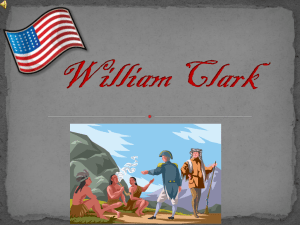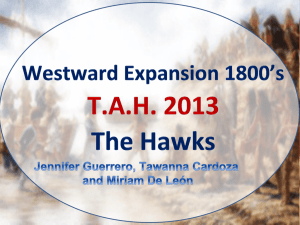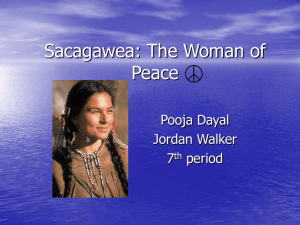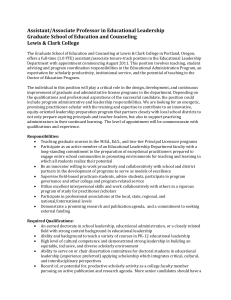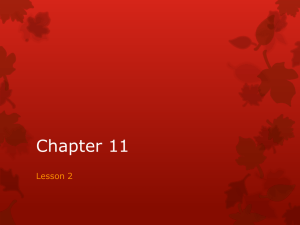Writing Prompt 8: Exploring the New America
advertisement
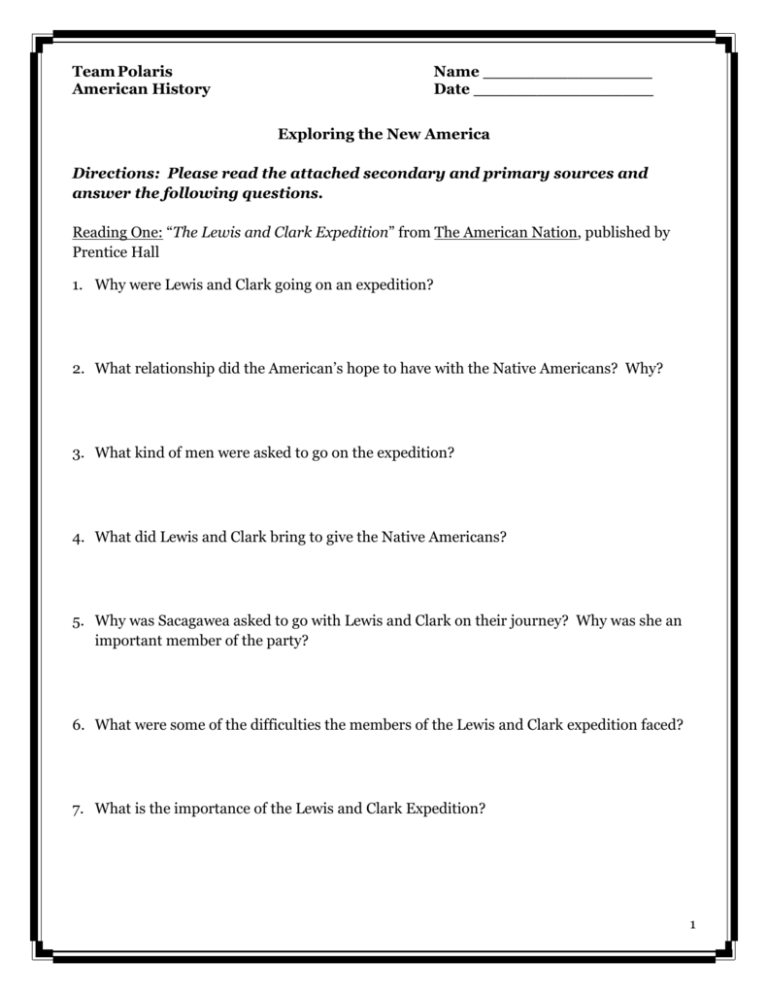
Team Polaris American History Name ________________ Date _________________ Exploring the New America Directions: Please read the attached secondary and primary sources and answer the following questions. Reading One: “The Lewis and Clark Expedition” from The American Nation, published by Prentice Hall 1. Why were Lewis and Clark going on an expedition? 2. What relationship did the American’s hope to have with the Native Americans? Why? 3. What kind of men were asked to go on the expedition? 4. What did Lewis and Clark bring to give the Native Americans? 5. Why was Sacagawea asked to go with Lewis and Clark on their journey? Why was she an important member of the party? 6. What were some of the difficulties the members of the Lewis and Clark expedition faced? 7. What is the importance of the Lewis and Clark Expedition? 1 The Lewis and Clark Expedition Planning an Expedition Few Americans knew anything about the Louisiana territory. In 1803, Congress provided money for a team of explorers to study the new lands. Jefferson chose Meriwether Lewis, his private secretary, to head the expedition, or long voyage of exploration. Lewis asked William Clark to go with him. Jefferson asked Lewis and Clark to map a route to the Pacific Ocean. He also told them to study the geography of the territory, including: “… climate as characterized by the thermometer, by the proportion of rainy, cloudy, and clear days, by lightning, hail, snow, ice … the dates at which particular plants put forth or lose their flower, or leaf, times of appearance of particular birds, reptiles or insects.” — Thomas Jefferson, letter to Meriwether Lewis, 1803 Jefferson also instructed Lewis and Clark to learn about the Indian nations who lived in the Louisiana Purchase. These Native Americans carried on a busy trade with English, French, and Spanish merchants. Jefferson hoped that the Indians might trade with American merchants instead. Therefore, he urged Lewis and Clark to tell the Indians of “our wish to be neighborly, friendly, and useful to them.” The Lewis and Clark Expedition Dozens of adventurous young men eagerly competed to join the expedition. Lewis and Clark judged volunteers on the basis of their character, strength, hunting skills, and ability to survive in the wilderness. In the end, about 50 men made up the “Corps of Discovery.” The party also included York, an enslaved African American who had been Clark's companion since boyhood. In May 1804, Lewis and Clark started up the Missouri River from St. Louis. At first, the expedition's boats made slow progress against the Missouri's swift current. One night, the current tore away the riverbank where they were camping. The party had to scramble into the boats to avoid being swept downstream. Across the Plains Lewis and Clark marveled at the broad, grassy plains that stretched “as far as the eye can reach.” Everywhere, they saw “immense herds of buffalo, deer, elk, and antelope.” As they traveled across the plains, the expedition met people of various Indian nations. Lewis and Clark had brought many gifts for Native Americans. They carried “peace medals” stamped with the United States seal. They also brought mirrors, beads, knives, blankets, and thousands of sewing needles and fishhooks. During the first winter, Lewis and Clark stayed with the Mandan’s in present-day North Dakota. The explorers planned to continue up the Missouri in the spring. However, they worried about how they would cross the steep Rocky Mountains. 2 Also staying with the Mandan’s was an Indian woman named Sacagawea (sahk uh guh wee uh). Sacagawea belonged to the Shoshone (shoh shoh nee) people, who lived in the Rockies. She and her French Canadian husband agreed to accompany Lewis and Clark as translators. Over the Rockies In early spring, the party set out. In the foothills of the Rockies, the landscape and wildlife changed. Bighorn sheep ran along the high hills. The thorns of prickly pear cactus jabbed the explorers' moccasins. Once, a grizzly bear chased Lewis while he was exploring alone. Finally, Lewis and Clark met some Shoshones. One of them was Sacagawea's brother, whom she had not seen for many Lewis and Clark with Native American translator years. Upon seeing her own people, wrote Sacagawea Clark, she began to “dance and show every mark of the most extravagant joy.” The Shoshones supplied the expedition with food and horses. They also advised Lewis and Clark about the best route to take over the Rockies. In the Rocky Mountains, Lewis and Clark crossed the Continental Divide. A continental divide is a mountain ridge that separates river systems flowing toward opposite sides of a continent. In North America, some rivers flow east from the Rockies into the Mississippi, which drains into the Gulf of Mexico. Other rivers flow west from the Rockies and empty into the Pacific Ocean. To the Pacific After building canoes, Lewis and Clark's party floated toward the Columbia River into the Pacific Northwest. Finally, on November 7, 1805, Clark wrote in his journal, “Great joy in camp. We are in view of the ocean, this great Pacific Ocean which we have been so long anxious to see.” Lewis and Clark had reached their goal. The return trip to St. Louis took another year. In 1806, Americans celebrated the return of Lewis and Clark. The explorers brought back much useful information about the Louisiana Purchase. Sacagawea Sacagawea proved invaluable to the Lewis and Clark expedition. Because she knew about the healing qualities of plants and herbs, the expedition relied on her for medical help. The presence of Sacagawea and her baby showed Indians in the area that the party was friendly. As Clark noted, “a woman with a party of men is a token of peace.” She helped win the needed gift of horses from her people, the Shoshone. After the journey was completed, Clark wrote that she “deserved a greater reward … than we had in our power to give her.” 3 Reading Two: “Journal entry of Sergeant Patrick Gass” from The Journals of the Lewis and Clark Expedition, University of Nebraska Lincoln, October 2, 1804 1. Describe the geography that Gass saw in this leg of the journey. 2. What interaction did Gass and the men have with Native American’s according to this journal entry? 3. Why would Gass and the men give the Native American’s a flag and a medal? Describe what the medal looked like. Sergeant Patrick Gass (1771–1870). Born in Pennsylvania, of Irish ancestry, he belonged to Captain Russell Bissell's company of the First Infantry, having joined the army in 1799 after service in a volunteer Ranger unit. He was promoted from private to sergeant in August of 1804, having officially joined the expedition on January 1, 1804. His skill as a carpenter was of great value to the expedition. His journal, published in 1807 after considerable alteration, was the first journal from the expedition to see publication. Tuesday 2nd. [October 2, 1804] We set sail before day light. A Frenchman [7] came on board, who could speak English. He mentioned it as his opinion, that we should see no more Indians, until we should arrive at the nation of Rees. We passed a range of black bluffs on the north side and a large bottom on the south, where there was some timber on the bank of the river. About 2 o'clock we discovered some Indians on the hills on the north side, and one of them came down to the bank and fired a gun; the object or intention we did not well understand, but were ready to meet an attack. We passed black bluffs on the south side, an island covered with timber, and a handsome bottom on the north side. We halted and spoke to the Indian, who said he belonged to the Jonkta or Babarole band, [8] and that there were 20 lodges of them. We told him we had seen two of their chiefs, and given them a flag and medal. [9] We passed a creek on the south side, and encamped on a sand bar in the middle of the river. 7. Jean Vallé, a trader of Ste. Genevieve, Missouri. 8. Evidently either the Yankton or Bois Brulé divisions of the Sioux. 9. Presenting medals to Indian dignitaries was a longstanding custom. Lewis and Clark carried medals of various sizes and inscriptions. The most common displayed the profile of President Jefferson on one side, while the reverse showed clasped hands and crossed tomahawk and pipe. 4 Writing Prompt 8: Exploring the New America 1. You will begin your prompt with the 4th generation character (the child of the person who died in the last prompt). What is his/her name, how old is he/she, what is his/her gender? 2. You begin this prompt in the year 1803, just after Jefferson has purchased Louisiana, doubling the size of the United States. 3. As you are walking in your village, you notice a flyer created by the government. Jefferson is asking for volunteers to be part of an expedition exploring the new land he just purchased. Lewis and Clark will be holding the competition to see who gets to be part of this “Corps of Discovery.” Be sure to include in your prompt a description of what kind of person Jefferson is looking for. 4. You decide you would like to volunteer to be part of the Corps, so make a plan to attend the competition. 5. When you arrive at the competition with a close friend, Meriwether Lewis explains to the crowd of competitors the purpose of this exploration. (Please use quotes and information from the readings!) 6. As the competition is about to begin, your character is met with a shock. Scenario #1: Pro-Jefferson 1. If your 3rd generation character went against Adams and the Alien and Sedition Acts in prompt 7, your 4th generation character is welcomed to the competition with open arms. In fact, when Lewis and Clark see you, they inform you that you do not have to compete! Because of your parents’ loyalty to Jefferson and the DemocraticRepublicans, you are granted an automatic spot in the Corps of Discovery. Try to capture the excitement you have at being chosen to explore this new land. 2. As you take part in the expedition, you keep a journal to track your findings and experiences. Include in your prompt three journal entries with appropriate dates from the expedition. The entries must include information about: a. Sacagawea, the Shoshone’s, and interactions with Native Americans. b. Crossing the Continental Divide. c. Reaching the Pacific Ocean. 3. Your journal must also include at least two images of new plants, animals, or land that the Corps of Discovery finds. 4. You must end your prompt in 1806. You have arrived home from the expedition and are reflecting back on two specific things: a. How important the expedition was and why. b. How proud your mother/father would have been that you were a part of the expedition. Does taking part in this journey make you a true American? 5 Scenario #2: Anti-Jefferson 1. If your 3rd generation character supported Adams and the Alien and Sedition Acts in prompt 7, your 4th generation character is shunned at the competition immediately. In fact, when Lewis and Clark see you, they inform you that you cannot compete to join the Corps! Because of your parents’ disloyalty to Jefferson and the DemocraticRepublicans, you are automatically blocked from having a spot in the Corps of Discovery. Try to capture the anger and disappointment you have at not being able to be part of the exploration of his new land. 2. Your close friend, however, earns a spot in the Corps of Discovery. He keeps a journal to track his findings and experiences. Include in your prompt three journal entries with appropriate dates from the expedition. The entries must include information about: a. Sacagawea, the Shoshone’s, and interactions with Native Americans b. Crossing the Continental Divide c. Reaching the Pacific Ocean 3. Your friend’s journal must also include at least two images of new plants, animals, or land that the Corps of Discovery finds. 4. You must end your prompt in 1806. Your friend has arrived home from the expedition and has given you his journal to read. When you are finished reading it, you reflect back on two specific things: a. How important the expedition was and why. b. How disappointed your mother/father would have been that you were not part of the expedition. Even though you were not allowed to take part in this journey, are you a true American? 6 Peer Evaluation – Writing Prompt #8 Name of Writer: _____________________ Name of Evaluator: ___________________ Directions: Please put a check in the space provided if the story contains the information. You will then add up the check marks to determine the point value. Remember, if you cannot prove where you found the check mark, you will lose the point! Does the story contain the following? 1. Does the story contain a name and description of the 4th generation character? _____ 2. Does the story mention the year and how old the character is? _____ 3. Does the story mention that Jefferson just purchased the new land of Louisiana, doubling the size of the nation? _____ 4. Does the story describe what kind of person Jefferson is looking for? _____ 5. Does the story describe the purpose of the exploration? _____ 6. Does the story describe why the character is given an automatic spot in or automatically blocked from the Corps? _____ 7. Does the story describe the characters reaction to this? _____ 8. Does the story contain a journal that describes meeting Sacagawea, the Shoshone tribe and the Corps’ interaction with Native Americans? _____ 9. Does the story contain a journal that describes crossing the Continental Divide and what that is? _____ 10. Does the story contain a journal that describes reaching the Pacific Ocean? _____ 11. Does each journal have an appropriate date? _____ 12. Does the story include two images from the expedition? _____ 13. Does the story explain why the expedition was so important? _____ 14. Does the story describe what the reaction of the character’s mother/father would have been? _____ 15. Does the story mention the character thinking about if they are a true American? ____ 16. Does the story contain dialogue? _____ Total Points______/16 Overall Point of View (What did you think of the story?) 7
